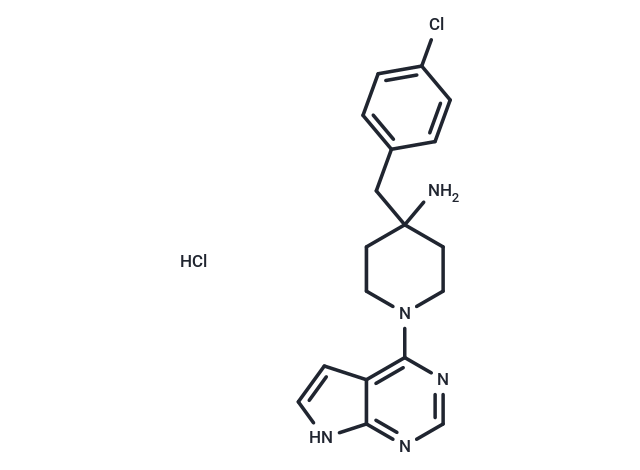Shopping Cart
- Remove All
 Your shopping cart is currently empty
Your shopping cart is currently empty

CCT128930 hydrochloride (CCT128930 hydrochloride) is a potent and selective inhibitor of AKT with IC50 of 6 nM. CCT128930 hydrochloride induces cell cycle arrest, DNA damage, and autophagy. CCT128930 hydrochloride has 28-fold selectivity over the closely related PKA kinase (IC50: 168 nM) through the targeting of Met282 of AKT, as well as 20-fold selectivity over p70S6K (IC50: 120 nM).

| Pack Size | Price | Availability | Quantity |
|---|---|---|---|
| 1 mg | $54 | In Stock | |
| 5 mg | $98 | In Stock | |
| 10 mg | $159 | In Stock | |
| 25 mg | $267 | In Stock | |
| 50 mg | $398 | In Stock | |
| 100 mg | $582 | In Stock | |
| 1 mL x 10 mM (in DMSO) | $118 | In Stock |
| Description | CCT128930 hydrochloride (CCT128930 hydrochloride) is a potent and selective inhibitor of AKT with IC50 of 6 nM. CCT128930 hydrochloride induces cell cycle arrest, DNA damage, and autophagy. CCT128930 hydrochloride has 28-fold selectivity over the closely related PKA kinase (IC50: 168 nM) through the targeting of Met282 of AKT, as well as 20-fold selectivity over p70S6K (IC50: 120 nM). |
| Targets&IC50 | PKA:168 nM, p70 S6K:120 nM, Akt2:6 nM |
| In vitro | In U87MG human glioblastoma cells, CCT128930 hydrochloride(0.1-60 μM; 1 hour) shows an initial induction of AKT phosphorylation at serine 473 up to 20 μM, followed by a decreased in phosphorylation at higher concentrations[1]. CCT128930 (18.9 μM) hydrochloride causes an increase in phosphorylation of pSer473 AKT after 30 minutes, which is sustained for 48 hours. Total AKT protein signal decreases gradually from 8 hours to 48 hours of treatment[1]. The GI50 values of CCT128930 hydrochloride for growth inhibition are 6.3 μM for U87MG human glioblastoma cells, 0.35 μM for LNCaP human prostate cancer cells, and 1.9 μM for PC3 human prostate cancer cells, all of which are PTEN-deficient human tumor cell lines[1]. CCT128930 hydrochloride inhibits direct substrates of AKT (Ser9 GSK3β, pThr246 PRAS40 and pT24 FOXO1/p32 FOXO3a) at ≥5 μM, and the downstream target, pSer235/236 S6RP at ≥10 μM, with generally constant levels of the respective total proteins and GAPDH[1]. |
| In vivo | CCT128930 hydrochloride shows antitumor activities in U87MG and BT474 human breast cancer xenografts[1]. |
| Alias | CCT128930 hydrochloride(885499-61-6 Free base) |
| Molecular Weight | 378.3 |
| Formula | C18H21Cl2N5 |
| Cas No. | 2453324-32-6 |
| Smiles | Cl.NC1(Cc2ccc(Cl)cc2)CCN(CC1)c1ncnc2[nH]ccc12 |
| Relative Density. | no data available |
| Storage | Powder: -20°C for 3 years | In solvent: -80°C for 1 year | Shipping with blue ice. | |||||||||||||||||||||||||||||||||||
| Solubility Information | DMSO: 55 mg/mL (145.39 mM) | |||||||||||||||||||||||||||||||||||
Solution Preparation Table | ||||||||||||||||||||||||||||||||||||
DMSO
| ||||||||||||||||||||||||||||||||||||

Copyright © 2015-2024 TargetMol Chemicals Inc. All Rights Reserved.